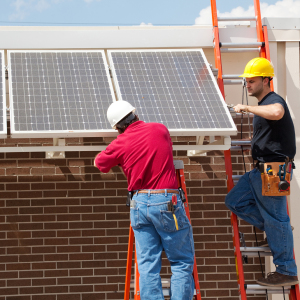“Oops. I think we put those solar panels on the wrong way.”
That isn’t something most Americans want to hear when their friendly neighborhood solar technician climbs down the ladder after installing a rooftop solar system that may take twenty or thirty years to pay-off. But it turns out that most rooftop solar systems may be “on the wrong way,” even if they’ve been perfectly and professionally installed, if they face south rather than west, which an estimated nine out of ten do.
The recent rush to pave-over every American rooftop with solar panels has one major flaw, according to emerging new thinking in the field. Most of these systems face south, when pointing them west makes much more sense. It’s a case of misdirection, literally, that’s all too typical of the fly-by-night way this industry is evolving.
South-facing panels may generate more electricity throughout the day (assuming the sun’s shining), but demand for any surplus power they generate also slumps during those midday hours, since many of us are off at work, at school, or just aren’t using as much juice as we do in the morning and evening.
Typical residential energy use surges in the morning, when we all get up, but levels out or dips in the midday hours when a lot of Americans aren’t home. Another upward surge comes later in the day, usually around 5:00 pm, when the sun is heading for the Western horizon. That’s the time of day when people return home, make dinner, turn-on lights, use their devices and appliances, etc.
It’s during this late afternoon surge in use and demand that the grid needs all the extra electrons it can get. Problem is, south-facing panels at that time of day can do the hungry grid little good, since a setting sun isn’t packing the punch it did earlier in the day, when those extra electrons weren’t as needed or helpful.
Here’s the takeaway: Most residential solar panels are producing surplus power at times when that power is least useful to customers or the grid.
There’s a major misalignment between residential solar energy producers and the grid into which they feed surplus power, due to a lack of foresight and an all-too-typical indifference to how the grid actually works. If rooftop solar is generating too much surplus power when it isn’t needed, but too little surplus power when it is, aren’t we greatly undermining the point of the exercise?
It’s clear that homeowners would be doing themselves and the grid much more good by pointing panels west, rather than south. But only 9 percent of today’s rooftop arrays face west, while 91 percent face south. South isn’t necessarily the wrong direction; but it isn’t really the best direction to face panels if we want to get the most bang for our solar power buck.
This disconnect isn’t just a problem for the grid. It’s also potentially hurting residential solar users, depending on the contracts they have with their solar system providers and utility companies. If these folks had west-facing panels (which most don’t) and a plan that pays them a fluctuating, demand-based rate for their surplus power (which most don’t), they could be selling their late-day power at higher prices, since that’s when demand is up. Unfortunately for many, however, they’re stuck with flat rate plans that are completely disconnected from market or grid dynamics.
Some residential solar users probably couldn’t care less about such technicalities. As long as the meter is running backward at some point in the day, they’re happy campers. They just want to make themselves feel better about their energy choices and maybe “save the planet” along the way. And why would companies rushing to cash-in on the solar craze care? They just want to sell equipment and sign-up people for lucrative long-term contracts and loans.
But the rest of us should care about it, since we’re often subsidizing the solar fad with diverted tax or ratepayer dollars, on the premise that this is doing something significant to alter the energy landscape. If solar power is delivering less bang for the buck than promised, as this situation suggests, the rest of us are getting ripped-off and taken for a ride.

